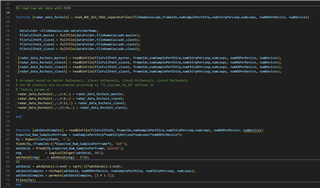Other Parts Discussed in Thread: TDA2, MMWAVE-DFP
Tool/software:
Hello,
I recently worked on range-Doppler map extraction from the data received by the MMWCAS-DSP-EVM. My final goal is to extract and process data from this device in order to perform post-processing myself, but using all the benefits of this device (the multi-TX property and the possibility to perform elevation sensing with a 2D planar configuration of TX antennas).
However, I don't seem to be able to set up mmWave Studio in order to extract an ADC data file containing what I'm expecting. If I'm using a single TX antenna, I already know how to configure the device in order to have a file with a size of (num_frames * size_of_a_frame), where the size of a single frame is given by (num_adc_samples * num_chirps_per_frame * num_RX_antennas) - from there, extracting the RDC and a range-Doppler map is not trivial, but it has already been done.
How would I set up my device in order to operate in a MIMO configuration? At the moment I'm OK to understand how to set up a single device, in order to see how parameters affect the data capture on a lower scale, and then I will proceed to extend this ina second moment.
Thanks in advice,
Luca


